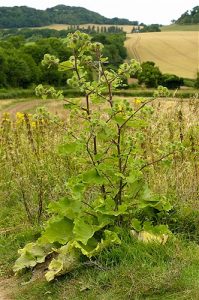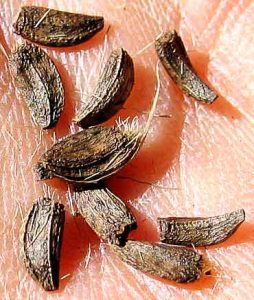Burdock
(Arctium lappa)
- Alias names for Burdock: Lappa, Lappa Minor, Hill, thorny Burr, Lappa Major, Lappa Tomentosa, Burdock Root, Beggar’s Buttons, Hareburr, Clot-bur, Bardana (Note: Lappa means to seize and Arktos means bear)
- Chinese Names for Burdock: Gobo (Root), Niu bang zi (Seeds)
Pictures of Burdock:
Burdock seed heads (some people call these cockleburs) and Great Burdock plant
Picture of Burdock seedling, seeds and Burdock root:
References for Burdock pictures:
- https://www.floralimages.co.uk/parctilappa.htm
- Google Images (Seedling, seeds and root)
About Burdock: Burdock is a biennial plant which can grow up to 5 feet tall whose leaves and fruit are harvested in late summer. Burdock is usually mixed with other herbs like dandelion. Native to Europe and Asia, burdock now grows in temperate regions around the world.
Actions and Uses of Burdock:
- Abscesses
- Acne
- Antibiotic (Fresh root)
- Antifungal
- Antiseptic
- Anti-tumor action
- Boils
- Cleansing and Detoxifying (Western and Chinese medicine)
- Diaphoretic (mild)
- Eczema
- Gout
- Heavy metal toxicity
- Hypoglycemic-Lowers blood sugar levels
- Kidney Stones
- Local skin infections
- Mild diuretic
- Psoriasis
- Smooth Muscle Relaxant (Arctiin)
How Burdock is used and how it Works:
Burdock promotes flow of secretions of the body without irritating qualities. It has a gentle laxative effect and stimulates digestive action within the stomach.
- Dried leaves for infusion tea
- Dried root from first-year plants (harvested mid-summer) helps in detoxification of the skin and chronic conditions
- Burdock seeds (harvested in summer) have cleansing properties in removing toxins in fevers and infections such as mumps and measles. Niu bang zi (Chinese) use the seeds to dispel wing and heat evils and to lower blood sugar
- Root decoction for arthritis and skin disorders
- Root tincture is used for digestion and urinary stones
- Seed infusion used as a wash for acne and boils
- Leaf poultice applied to abscesses, boils and ulcers
- Infused oil is used for varicose ulcers
Parts of the Burdock Plant Used: First year root, seeds, leaves and fruit
Properties of Burdock: Alterative, diuretic, diaphoretic, nutritive, cool/bitter/slightly sweet
Chemical Constituents of Burdock: Bitter glycosides (arctiopicrin), Flavonoids (arctiin), Tannins, Polyacetylenes, Volatile oil
Contraindications, safety issues, concerns, harmful drug interactions and allergy precautions for Burdock: There are no known safety concerns, contraindications or allergies associated with the use of burdock. There are no known harmful drug interactions associated with burdock. However, the compound inulin, which is found in burdock, may reduce blood sugar significantly enough to interact with blood sugar medications. If you are diabetic, consult a physician before using burdock.
Helpful Links and References for Burdock:
- Japanese Recipes using Gobo (Burdock): https://japanesefood.about.com/library/pictures/blkinpiragobo.htm
- Google Images of Burdock has lots of useful links
These products are not drugs, but foods for special dietary use pursuant to applicable Federal law. No statement in this page shall be construed as offering these products for the diagnosis, cure, mitigation, treatment, or prevention of any disease.
Related Pages:

